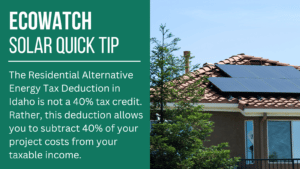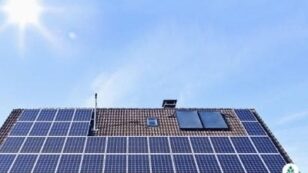 Reviews
Reviews
Idaho Solar Incentives (Rebates, Tax Credits & More in 2024)
In this guide to saving money with solar incentives in Idaho, you’ll learn:
- What solar benefit programs are available in Idaho?
- How do the solar incentives in Idaho affect the installation cost of solar panels?
- How do you file for the federal solar credit in Idaho to make sure you get the full amount?
Each product and or company featured here has been independently selected by the writer. You can learn more about our review methodology here. If you make a purchase using the links included, we may earn commission.
Do Idaho Solar Incentives Make It Affordable for Homeowners to Go Solar?
Yes! In Idaho the solar perks available can effectively bring down your conversion costs by thousands of dollars.
The average cost of installing a solar energy system in Idaho is around $32,600, assuming you need the typical system size of 10 kilowatts (kW) — which is above the national average of 9 kW — and pay around the local average of $3.26 per watt — which is slightly below the U.S. average of $2.33.
The solar incentives in the state aren’t as plentiful as they are elsewhere — likely due to the fact that it doesn’t have a Renewable Portfolio Standard (RPS) goal to incentivize solar adoption.1
However, the few incentives that are available provide exceptional value for Idaho homeowners. These perks can help make your panels far more affordable and can help maximize your long-term solar savings.

Blue Raven Solar
Pros
- Industry-leading in-house financing
- Competitive pricing
- Excellent reputation
Cons
- Doesn't offer solar batteries (coming 2022)

EGT Solar

Local Service
Average cost
Pros
- Representatives are experts on local policies
- Outstanding customer service
- Offers products from leading manufacturers
Cons
- Limited information available on website
- Slightly limited service offerings
- No leases or PPAs

Blue Raven Solar
Pros
- Industry-leading in-house financing
- Competitive pricing
- Excellent reputation
Cons
- Doesn't offer solar batteries (coming 2022)
In the table below, we’ll include a quick breakdown of all of the solar benefit programs available in Idaho, and we’ll explain each in greater depth in the sections that follow.
| Solar Incentives in Idaho | Incentive Type | Description | Occurrence | Estimated Dollar Amount You Can Receive |
| Federal Solar Investment Tax Credit (ITC) | Federal | This is a credit that gets applied to the income taxes you owe for the year you go solar. It’s for 30% of your system total. | One-time: Gets applied once when you file your taxes after adopting solar | $9,780 on average in Idaho |
| Residential Alternative Energy Tax Deduction | State | This is a state deduction that lowers your taxable income by 40% of your system’s cost. It has a cap of $5,000 per year or $20,000 total. | Ongoing for four years: Gets applied once when you file your taxes at 40% and then once per year for three years at 20% of the system cost. | $1,000 per year for five years on average in Idaho |
| Net Metering | Local | Credits you for excess energy produced and sent to the grid. Those credits can be used to reduce future effective energy usage. | Ongoing: Credits accrue for the life of your solar power system and continue to apply to future utility bills. | Varies based on your system size, your average monthly energy bills and more |
| Low-Interest State Energy Loans | Local | Provides loans for going solar with capped interest rates (4%) and low down payment requirements to make solar more accessible. | One-time: Gets applied once when you apply for the program. | Varies based on system size, system cost and more |
What Do Idahoans Need to Know About the Federal Solar Tax Credit?
The federal solar tax credit (ITC) is one of the most significant perks solar customers will see in Idaho. It’s offered by the federal government and is available to all U.S. solar customers. It was first made available in 2005.
Thanks to the Inflation Reduction Act (IRA) signed by Congress in 2022, the federal credit was pushed up from 26% back to 30% and extended by ten years. The new rate reduction schedule is as follows:
- 30% credit for all systems installed between 2022 and 2032
- 26% credit for all systems installed in 2033
- 22% credit for all systems installed in 2034
- The credit is scheduled to disappear in 2035
The federal credit is for 30% of your system value, which averages out to $9,780 in Idaho. This amount gets credited to the taxes you owe for the year your system is installed, although it can be rolled over for up to five years.
How to Claim the Federal ITC in Idaho
Claiming the federal credit in Idaho is a simple process, so the return on your time investment is outstanding. You can follow the steps below to ensure you take full advantage of this perk.
- Step 1:Head over to the IRS’s website and print out IRS form 5695. This is the form for notifying the taxation department of residential energy credits for which you are eligible.
- Step 2: Fill out the form. You’ll need some basic information about your system — like the cost, the size and the address where it was installed — as well as information about the installer — including contact information.
- Step 3: When you’re ready to file your taxes for the year your system was installed, make sure you include the completed form.
Filing for the federal credit is even simpler if you use tax software like TurboTax or HR Block. Both programs prompt you to check if you installed any renewable energy equipment or made any energy efficiency upgrades to your home. Just click yes and follow the prompts.
EcoWatch’s Opinion on the Federal ITC in Idaho
In most states, the federal credit is the most beneficial perk for solar conversion. That’s not the case in Idaho because the state credit provides more potential value. Still, the federal credit can provide potential savings that average around $9,780. Not only are the savings outstanding, but the credit takes just a few minutes to apply for.
We should note that this is a credit you get on your taxes and not a solar rebate. That means you’re not guaranteed to get the full — or any — credit value. If you don’t owe money on your personal income taxes when you file, then you can’t take advantage of this benefit program.
Since you can roll over the credit value for five years, you’ll need to owe an average of around $1,956 per year on your taxes for five years to take the full credit value.
Watch Below: What Should You Know Before Going Solar?
What You Should Know About the Residential Alternative Energy Tax Deduction in Idaho
In addition to the federal credit, Idaho residents also have access to the state tax credit, which provides even more value for energy efficiency improvements like solar conversion.
This perk provides a deduction in the amount of 40% of your system value for the first year and 20% per year for three years after that. The annual credit is capped at $5,000, and the total credit over the four years is capped at $20,000.
There are a few key differences between this tax deduction and the federal solar tax credit, however. This is a tax deduction, meaning that you can subtract 40% of the project costs from your taxable income, not that you will receive $20,000 via tax credits.
So, for instance, if you make $100,000 in a year, and your system cost you $25,000, you would be able to deduct 40% of $25,000 from your taxable income (which equals $10,000). Since the maximum deduction per year is $5,000, that means your taxable income in year one would be $95,000 rather than $100,000.
How to Claim Idaho’s Residential Alternative Energy Tax Deduction
Much like the federal credit, the state solar deduction includes a simple and quick application process. You can follow the steps below to ensure you take advantage of this perk.
- Step 1: Go to the Idaho State Tax Commission website and print out form 39R.
- Step 2: Fill out the form. You’ll need information about your PV system and solar panel installation company. Most of the information required is the same that you filled out on the federal form.
- Step 3: File form 39R along with your state taxes. If you’re using a tax software, it should prompt you for information automatically and won’t require you to print the form yourself.
EcoWatch’s Opinion on the Residential Alternative Energy Tax Deduction in Idaho
It’s common for residents to think that this incentive works similarly to the ITC, meaning you can receive thousands of dollars in tax credits against the taxes you owe. This is not the case, as this is a tax deduction rather than a tax credit.
While this incentive does not provide the same return as the ITC, it can still provide excellent value if you’re in a high tax bracket. Our example above (where a homeowner makes $100,000 in a year and purchases a $25,000 system) would provide just under $1,000 per year in savings over five years.
While this does not match the value of the federal tax credit, it can still make a big difference come tax season.
What You Should Know About the Low-Interest State Energy Loans in Idaho
The last incentive available we’ll discuss is the low-interest solar energy loan program offered by the state. This perk provides affordable and accessible solar loans to customers with an interest rate cap of 4% and minimal down payment requirements.
These loans help bring down the upfront cost of converting to solar in Idaho, although they do end up making PV equipment a bit more expensive due to the interest added on to the total.
How to Enroll in Idaho’s Low-Interest Energy Loans
Taking advantage of these loan options is a simple process. All you need to do is head to Idaho’s Office of Energy Resources (OER) website and apply for the loan program. You’ll need some basic information about your home and your monthly energy bills to apply.
Once you apply, you’ll be contacted by a program administrator to proceed with the solar installation process.
Keep in mind that the applications for this program are open from the summer through the end of each year.
EcoWatch’s Opinion on the Low-Interest Energy Loans in Idaho
Since solar is so expensive in Idaho, the low-interest energy loan program offered by the state is a great way to make clean energy more accessible.
Solar loans will always drive up your all-in cost to convert to solar energy, as you’ll pay interest on top of the original system total. However, these loans keep interest to a minimum, so we’d recommend these over private loans in most cases if you qualify.
Net Energy Metering in Idaho
Net energy metering is a billing policy offered by some utility providers and mandated by the Public Utilities Commission in many states. It’s one of the most popular solar incentives in the U.S. and also one of the most beneficial.
Net energy metering — or NEM — tracks your home solar production through interconnection and lets you “bank” excess power your panels produce that you don’t use. You can then call on that banked energy at a later date if your panels ever produce less than you use in your home.
As of 2024, the Public Utilities Commission (PUC) in Idaho adopted net billing instead of net metering, which credits you at a reduced cost per kWh you send to the grid. This is not ideal, but it’s still better than nothing. The three largest utility providers in the state have their own net metering policies, so rates can vary between the lower avoided cost rate and the full retail rate.
The credit rate varies based on your provider, so make sure to check with your power company before estimating your solar energy savings.
You should also note that net energy metering is changing in many states across the country, and it’s possible that the program will be altered or discontinued entirely in the future. There are no plans for this to happen, but it’s always a possibility.
How to Enroll in Net Energy Metering in Idaho
Before installing your solar energy system, your ID solar installer will apply on your behalf and enroll you in the local net metering program in your area. Before this can happen, you have the proper equipment installed (a bidirectional meter).
After your installation, your utility provider will most likely need to inspect your system before providing you with permission to operate (PTO). This can take a few weeks after the physical installation of your system is complete.
EcoWatch’s Opinion on Net Energy Metering in Idaho
Net energy metering is an outstanding solar benefit program no matter where you live, and it’s one of the most valuable perks in the long run. Ultimately, it helps maximize your long-term energy savings, which means it reduces your solar panel payback period and provides you with an actual return on your solar investment.
Which Tax Incentives Are the Best in Idaho?
We’ve discussed all of the solar benefits available to Idaho homeowners above, but not all of these perks are equally as beneficial as the others. Below, we’ll discuss what we believe are the best perks in your area and the ones we recommend you don’t miss out on.
Federal Tax Credit
The federal credit is also massively beneficial to Idahoans. It provides an average potential credit of $9,780. Combined with the state credit, this can make up for the entire system price.
The federal credit also cannot be taken if you don’t owe money on your federal tax return, but you can push any unused credit forward for up to five years.
The effective savings aren’t realized immediately, but this perk is still well worth the minimal time it takes to apply.
Net Energy Metering (NEM)
NEM is the third-most crucial perk to take advantage of in Idaho, if you have access to it. This policy is available to customers of Rocky Mountain Power, Idaho Power and Avista Utilities. While it’s not a universal option, it can help maximize your energy savings over time if you’re eligible.
The exact savings this policy will provide will vary based on your monthly electric bills and your system size. However, it does help Idaho residents push closer to or above the average lifetime savings of $17,308 in the area.
Best of all, NEM typically requires no effort on your part to enroll, so you’ll automatically get credited for each kilowatt-hour (kWh) your system sends to the grid.
What’s the Near Term Outlook For More Incentives in Idaho?
Many aspiring solar customers wonder about the future of rebates and incentives, as changes in policies can affect whether or not converting to solar in Idaho is worthwhile. At this time, there are no plans for additional incentives to become available or for existing ones to disappear in the state.
With that being said, we’d be remiss if we didn’t mention that net metering would likely be the policy to change if alterations to incentives are made. Many states are seeing changes to net metering policies, which typically make the program less beneficial by dropping the energy credit rate. Some policies are disappearing entirely.
Since Idaho doesn’t mandate net metering, it’s always possible that the utility companies that do offer it will abandon the policy. The Idaho Public Service Commission (IPSC) does push for net metering, even though it doesn’t mandate it. Idaho Power attempted to drop the credit rate to 50% in the recent past, but the IPSC denied the request.
As such, it’s our opinion that current solar incentives now will still be available in the foreseeable future.
The cost information presented in this article is derived from a comprehensive analysis, incorporating data from multiple industry sources. The average cost per watt per state was calculated based on figures from Consumer Affairs, Energy Sage, and Berkeley Lab’s Electricity Markets & Policy Department. Additionally, monthly energy consumption and the average monthly cost of electricity were sourced from the U.S. Energy Information Administration, ensuring a well-rounded and accurate representation of the information presented.
FAQ
In the sections below, we’ll include answers to some of the most common questions we see about solar benefit programs and the future of those perks in Idaho.
At this time, there are no plans to make more incentives available or to improve the existing incentives in Idaho. The federal credit did just increase from 26% back up to 30%, but this is the only positive change that was planned for solar incentives.
The Inflation Reduction Act (IRA) signed in 2022 made two important changes to renewable energy and energy efficiency policies available in Idaho.
First, it extended the federal credit by ten years and increased the credit rate back up to 30% through 2032. Second, it made the credits for electric vehicles (EVs) more enticing. The credit amount varies by make and model, but the maximum was bumped up to $7,500.
At this time, there are no plans to make solar incentives less appealing in the next two years, nor are there any plans to get rid of the incentives that exist.
If there is a negative change to the incentives currently available, it would likely be a reduction in the net metering credit amount — which local utility companies have pushed for in the past. The perk could disappear entirely as well, as it has in other states. This is especially possible because Idaho doesn’t have an RPS goal to incentivize solar adoption or net metering.
If the net metering program does disappear, solar batteries are a good way to get a similar advantage. You can include the cost of a battery in any free quote you get from an installer just to be prepared for the future.
Solar Renewable Energy Certificates (SRECs) are credits that solar customers earn for all solar production. Those energy credits can then be sold on the local SREC market for a profit. Unfortunately, Idaho does not currently have an SREC program. It’s unlikely that one will appear in the near future, given the lack of an RPS goal in the Gem State.
In some states, the value added to your home by your solar panels is exempted from property taxes. Unfortunately, ID does not have a property tax exemption, so both your home value and your taxes will go up as a result of converting to solar energy.
Top Solar Installers in Idaho Cities
Comparing authorized solar partners
-
- Industry-leading in-house financing
- Competitive pricing
- Excellent reputation
- Doesn't offer solar batteries (coming 2022)
A+Best Solar Financing2014Trina Solar, Canadian Solar, SolarEdge, Silfab, SunPower25-year manufacturer warranty; 10-year workmanship warranty, 2-year production guarantee
Having trouble deciding? Click below and use our process to receive multiple quotes instead:

 233k
233k  41k
41k  Subscribe
Subscribe 






